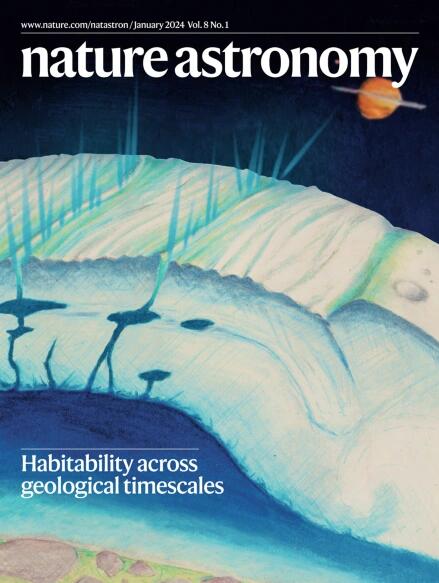在z = 3的一个紧密类星体对之间的丝状连接的高清晰度成像
IF 14.3
1区 物理与天体物理
Q1 ASTRONOMY & ASTROPHYSICS
引用次数: 0
摘要
连接光晕的细丝是冷暗物质理论的长期预测。在这里,我们展示了在MUSE超深场(MUDF)上用多单位光谱探测器(MUSE)仪器观测到的红移z≈3.22处连接两个类星体宿主星系的宇宙网发射。非常深入的观测揭开了细丝形态的高清视图,测量了星系间和星系周围介质之间的过渡半径,以及沿着细丝和横向方向的表面亮度曲线的特征。通过与模拟的系统比较,我们验证了当前冷暗物质模型中预测的细丝的典型密度。我们对MUDF(一个定量研究发射细丝的优秀实验室)的分析,为限制宇宙网的物理特性和在大尺度上追踪暗物质的分布开辟了一条新的途径。本文章由计算机程序翻译,如有差异,请以英文原文为准。


High-definition imaging of a filamentary connection between a close quasar pair at z = 3
Filaments connecting haloes are a long-standing prediction of cold-dark-matter theories. Here we present a detection of the cosmic web emission connecting two quasar-host galaxies at redshift z ≈ 3.22 in the MUSE Ultra Deep Field (MUDF), observed with the Multi Unit Spectroscopic Explorer (MUSE) instrument. The very deep observations unlock a high-definition view of the filament morphology, a measure of the transition radius between the intergalactic and circumgalactic medium, and the characterization of the surface brightness profiles along the filament and in the transverse direction. Through systematic comparisons with simulations, we validate the filaments’ typical density predicted in the current cold-dark-matter model. Our analysis of the MUDF, an excellent laboratory for quantitatively studying filaments in emission, opens a new avenue to constrain the physical properties of the cosmic web and to trace the distribution of dark matter on large scales. Deep optical imaging of a close quasar pair reveals a filamentary connection between them, providing insight into the transition between intergalactic and circumstellar media and a test of the cold-dark-matter cosmological theory.
求助全文
通过发布文献求助,成功后即可免费获取论文全文。
去求助
来源期刊

Nature Astronomy
Physics and Astronomy-Astronomy and Astrophysics
CiteScore
19.50
自引率
2.80%
发文量
252
期刊介绍:
Nature Astronomy, the oldest science, has played a significant role in the history of Nature. Throughout the years, pioneering discoveries such as the first quasar, exoplanet, and understanding of spiral nebulae have been reported in the journal. With the introduction of Nature Astronomy, the field now receives expanded coverage, welcoming research in astronomy, astrophysics, and planetary science. The primary objective is to encourage closer collaboration among researchers in these related areas.
Similar to other journals under the Nature brand, Nature Astronomy boasts a devoted team of professional editors, ensuring fairness and rigorous peer-review processes. The journal maintains high standards in copy-editing and production, ensuring timely publication and editorial independence.
In addition to original research, Nature Astronomy publishes a wide range of content, including Comments, Reviews, News and Views, Features, and Correspondence. This diverse collection covers various disciplines within astronomy and includes contributions from a diverse range of voices.
 求助内容:
求助内容: 应助结果提醒方式:
应助结果提醒方式:


